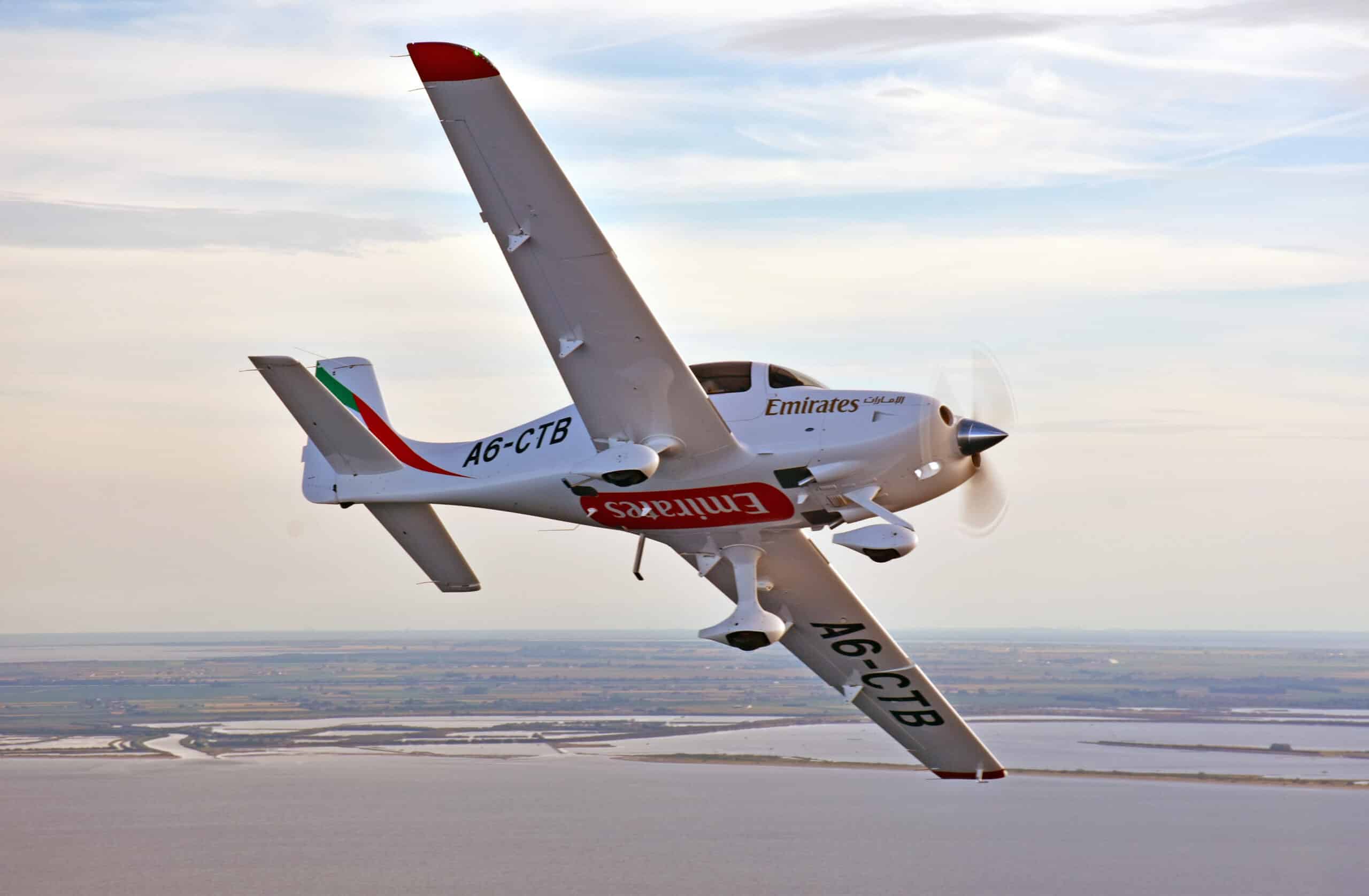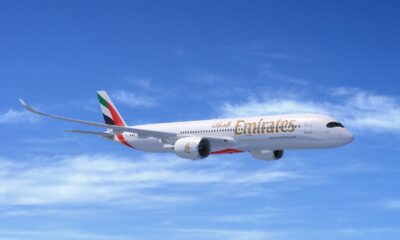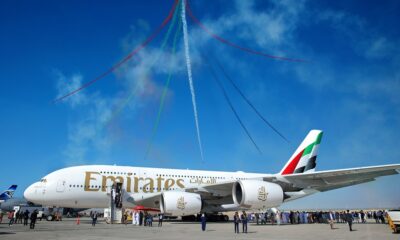Aerospace
Emirates Flight Training Academy receives delivery of first training aircraft

Dubai, U.A.E., 7 September 2017– Emirates Flight Training Academy, the state of the art flight training facility being developed by Emirates to respond to the global aviation industry’s need for pilots, has taken delivery of its first two Cirrus SR22 G6 training aircraft in Dubai. These are the first of the 22 single-piston engine Cirrus aircraft that have been ordered by the Academy to train ab initio pilots.
The two Cirrus SR22 G6 aircraft, A6-CTA and A6-CTB, landed in Dubai following a transatlantic journey spanning over 13,000 kilometres. Given the size of the aircraft and other restrictions including the size of the fuel tanks and range, the journey from Cirrus’ manufacturing facilities in the USA to Dubai had to be split into multiple segments.
Emirates’ Boeing 777 Fleet Tops 859,000 Flights..!(Opens in a new browser tab)
Upon completion of manufacture, the two aircraft were flown from Duluth, Minnesota to Knoxville, Tennessee – the location of Cirrus’ aircraft delivery centre. Once at the delivery centre, the aircraft were inspected and teams from Cirrus and Emirates Flight Training Academy went through a series of pre-flight appearance, functionality checks and test flights. The two Cirrus planes then embarked on an 11-stop transatlantic journey transiting through 10 countries flying an average of over 5 hours a day.
Flying out from Knoxville, A6-CTA and A6-CTB stopped at Portsmouth, New Hampshire, USA followed by Sept Iles and Iqaluit in Canada. From Iqaluit the two aircraft set out to cross the Atlantic Ocean in two stretches, stopping first at Nuuk in Greenland, then at Reykjavik in Iceland and completing the transatlantic sector at Wick in Scotland. These flights were also the longest segments in the aircraft’s journey from the US to Dubai.
Once in Europe, the two aircraft made their way from Scotland to Sywell in Northamptonshire, England and from thereon to Venice, Crete, Aqaba, Bahrain and finally to Dubai. All the flights were done in daylight and the two aircraft flew in loose formation throughout the entire journey allowing for easier air traffic clearances.
Watch a 360 video of the first two Cirrus aircraft landing in formation at Dubai International Airport.



The Cirrus SR22 G6 aircraft will form the backbone of the training fleet of the Emirates Flight Training Academy. The aircraft has a modern composite airframe; two large 12” flight displays; a flight management system keypad controller and an integrated engine indication and crew alerting system. The aircraft has a range of up to 1,207 nautical miles (1,943 kilometres) at speeds of 183 knots (340Km/H) TAS True Air Speed.
In addition to the 22 Cirrus SR22 G6 aircraft, Emirates Flight Training Academy has also placed an order for five twin-jet Embraer Phenom 100EV aircraft, becoming the first flight training organisation in the world to use the Phenom 100EV platform for training cadets.
The Emirates Flight Training Academy, located near Dubai World Central (DWC) airport in Dubai South, is designed to be one of the most advanced flight training facilities in the world. Scheduled to open in November 2017, the facility will be spread over an area of 200 football fields and will include ground school classrooms, ground based simulators, a young and modern training aircraft fleet, a 1,800 sq. m dedicated runway, an independent air traffic control tower and a maintenance centre in addition to accommodation and recreational facilities for cadets.
More details on entry requirements, eligibility and intake dates will be announced on http://www.emiratesflighttrainingacademy.com/

Aerospace
Which is bigger 777x or 787 aircraft ?

The 777X is a new series of the Boeing 777 family and is designed to be larger and more efficient than its predecessor. It features two variants: the 777-8 and the 777-9, being the larger of the two.
The Boeing 777X emerges as the larger sibling within the Boeing family, representing a significant leap forward in both size and efficiency. Comprising two variants, the 777-8 and the 777-9, the latter takes the crown as the larger of the two. With its expansive fuselage and impressive wingspan, the 777X is tailored for long-range journeys and boasts a substantial passenger capacity.
On the other hand, the Boeing 787, affectionately known as the Dreamliner, occupies a niche in the market as a smaller yet formidable aircraft designed for medium to long-range flights. Its distinguishing feature lies in its composite fuselage, a technological marvel that renders it lighter and more fuel-efficient compared to conventional aluminum counterparts. The Boeing 777X is larger than the Boeing 787 aircraft.
When it comes to passenger capacity, the 777-9 reigns supreme, typically accommodating a sizeable contingent of 400-425 passengers in its standard configuration. In contrast, the 787, with its more modest dimensions, typically carries between 240-290 passengers, depending on the variant and layout.
One of the remarkable innovations introduced with the 777X is its folding wingtips, a feature designed to address the logistical challenges of accommodating such a large aircraft in conventional airport gates. These folding wingtips enable the 777X to retract its wings, allowing it to fit into gates designed for smaller aircraft while still reaping the benefits of an extended wingspan during flight, thereby enhancing fuel efficiency and operational flexibility
Aerospace
China Secures Production Certificate for Mass Production of Pilotless eVTOL Aircraft

The first passenger-carrying pilotless electric vertical takeoff and landing (eVTOL) aircraft in the world, the EH216-S, has received the Production Certificate for its eVTOL aircraft from the Civil Aviation Administration of China (CAAC).
This is a significant milestone for EHang Holdings Limited, the leading UAM technology platform company in the world. This outstanding accomplishment is another big step towards mass manufacturing for the eVTOL aircraft and the ensuing commercial operations, building on the ground-breaking acquisition of the Type Certificate and the Standard Airworthiness Certificate for the EH216-S.
The PC is a crucial certificate that the aircraft maker receives from the CAAC, the country’s aviation authority. By obtaining this certificate, EHang has demonstrated that it has set up a quality management system for mass production that satisfies the airworthiness regulation standards set forth by the CAAC, and the company has been given permission to continue producing mass quantities.
It is also a strong guarantee of the calibre of the goods made by EHang. Raw materials, supplier management, manufacturing organisation, production quality control, aircraft pre-delivery test, after-sales repair and maintenance, etc. are all included in the mass production quality management system for the EH216-S.
To ensure that every aircraft and its components that roll off the production line strictly adhere to the approved type design and safety requirements, the system sets clear guidelines and documentation for every step in the production procedure. This ensures comprehensive traceability and safety control.
Aerospace
Four Airbus A380 Superjumbos lined up to be scrapped

In a strategic move aimed at reclaiming valuable resources from the iconic Airbus A380 aircraft, VAS Aero Services and Dr. Peters Group have announced a significant collaboration.
This partnership marks a milestone in aviation logistics and aftermarket services, with four of these colossal planes slated for teardown and redistribution of used serviceable material (USM).
The venture between VAS Aero Services, renowned for its expertise in aircraft dismantlement, and Dr. Peters Group, a prominent Germany-based investment fund management firm, underscores a commitment to sustainable aviation practices. This isn’t their first foray into scrapping A380s; their successful partnership has already seen the dismantlement of these aircraft, making them pioneers in this niche.
Under the agreement, the latest consignment brings the tally to eight A380s entrusted to VAS by Dr. Peters Group. Managing Director Christian Mailly of Dr. Peters Group emphasized the trust placed in VAS, citing their unparalleled capabilities in dismantlement and aftermarket sales network. It’s a strategic move in response to the growing demand for quality USM parts, particularly with the resurgence in reliance on the A380.
Notably, the teardown process will be carried out at various locations, optimizing the positioning of harvested parts to cater to different markets. While some parts will be positioned in Europe to support operators in the region and the Middle East, others will remain in the Asia-Pacific region. This meticulous strategy ensures efficient access to spare parts, benefiting MROs and airlines across these markets.
The decision to retire these A380s comes at a time when operators are reassessing fleet strategies amidst evolving market dynamics. Despite initial plans for quick retirement due to the emergence of more fuel-efficient alternatives, factors such as a rebound in long-haul demand and delays in new widebody deliveries have prompted operators to reconsider. The A380, with its unique capacity and capabilities, presents a practical solution for short-term capacity management.



























